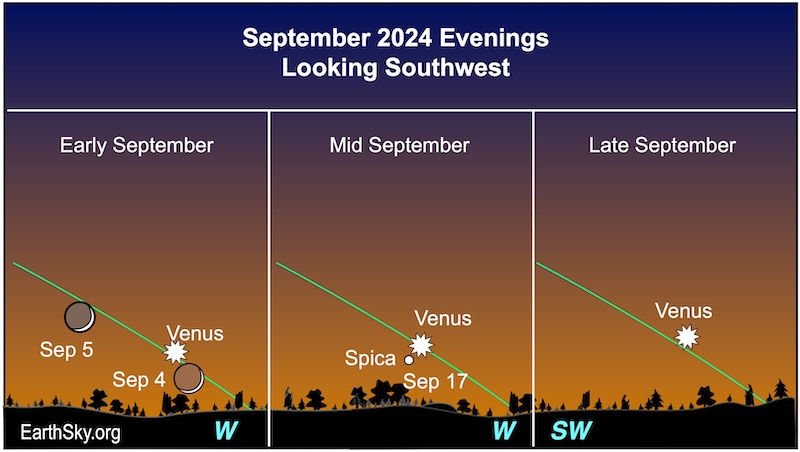[ Skywatchers ] [ Main Menu ]
48459

From: Eve, [DNS_Address]
Subject: Venus after sunset 2024: Back in the evening sky
URL: https://earthsky.org/astronomy-essentials/venus-after-sunset-greatest-elongation/
|
IMAGE CAPTION: In September 2024, look for Venus after sunset low along the western horizon. On September 4 and 5, the thin waxing crescent moon will float near Venus. In the middle of the month, Venus will lie near Spica, the brightest star in Virgo the Maiden. They are at their closest on the evening of September 17. During the rest of the month, bright Venus will shine low in the southwest shortly after sunset. Venus will continue to ascend and become a dazzling evening star through the end of the year. Itíll reach its greatest distance from the sun in January 2025. Chart via EarthSky. EXCERPT: In September 2024, Venus Ė Earthís brightest planet Ė is shining in the western twilight after sunset. Itíll remain visible in the evening sky through the rest of this year. Greatest elongation Ė when Venus will be farthest from the sunset Ė will come on January 9-10, 2025. You canít miss Venus! Itís exceedingly bright and will penetrate the bright twilight. What fun! So, in September, look in the sunset direction while the sky is darkening. As the weeks pass, Venus will appear higher and higher above the sunset. You canít miss it as the dazzling evening ďstar.Ē As the sunís 2nd planet, Venus is bound by an invisible tether to the sun in our sky. Itís always east before sunrise, or west after sunset (never overhead at midnight). Venus is the brightest planet visible from Earth and shines brilliantly throughout every morning or evening apparition. Greatest elongation happens when Venus is farthest from the sun on the skyís dome. ...more at link provided... |
Responses:
[48460]
48460

From: Eve, [DNS_Address]
Subject: Re: Venus after sunset 2024: Back in the evening sky
URL: https://astrophotographylens.com/blogs/astro/spica-star
|
An article (podcast) dated from couple of years ago regarding Venus and Spica: We often tell you about optical illusions in the night sky ó things that arenít what they seem. And a great example is in view right now: the planet Venus and the star Spica. Theyíre low in the southwest as evening twilight fades away. And the situation definitely isnít what it seems. Venus is the brilliant ďevening starĒ ó the brightest object in the night sky other than the Moon. Spica is close to the left of Venus tonight. The two objects will move closer over the next few evenings, though. By Sunday evening, Venus will stand a little above the star. Venus looks so bright because itís wrapped in reflective clouds, itís close to the Sun, and itís close to Earth ó about a hundred million miles at present. But Spica is about 15 million times farther than Venus is. If you lined them up at the same distance, Spica would look about 200 million million times brighter than Venus. So youíd have to spread them out to be able to see Venus at all through Spicaís glare. Another part of the illusion is the number of objects we see. Venus is a single planet. But Spica is a binary star ó two stars locked in a mutual orbit. Because of their great distance from Earth, though, their light blurs together to form a single pinpoint. The larger of Spicaís stars is more than 800 times wider than Venus ó completing a beautiful illusion in the early evening sky. link to text/podcast: https://stardate.org/podcast/2021-09-01 The image above is from the astrophotgraphylens link at the top. |
Responses:
None
[ Skywatchers ] [ Main Menu ]